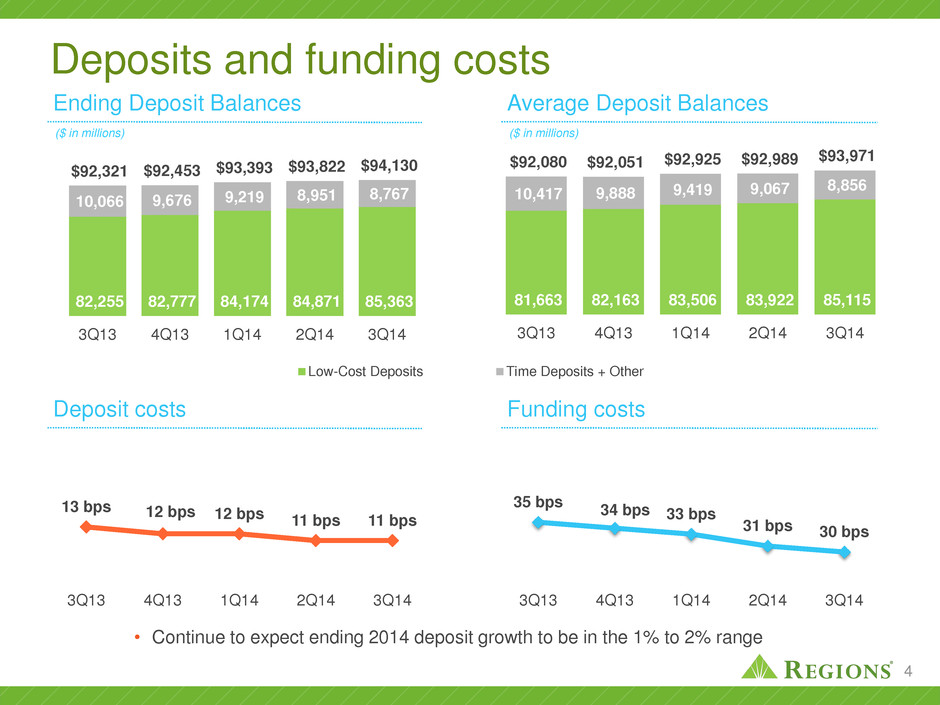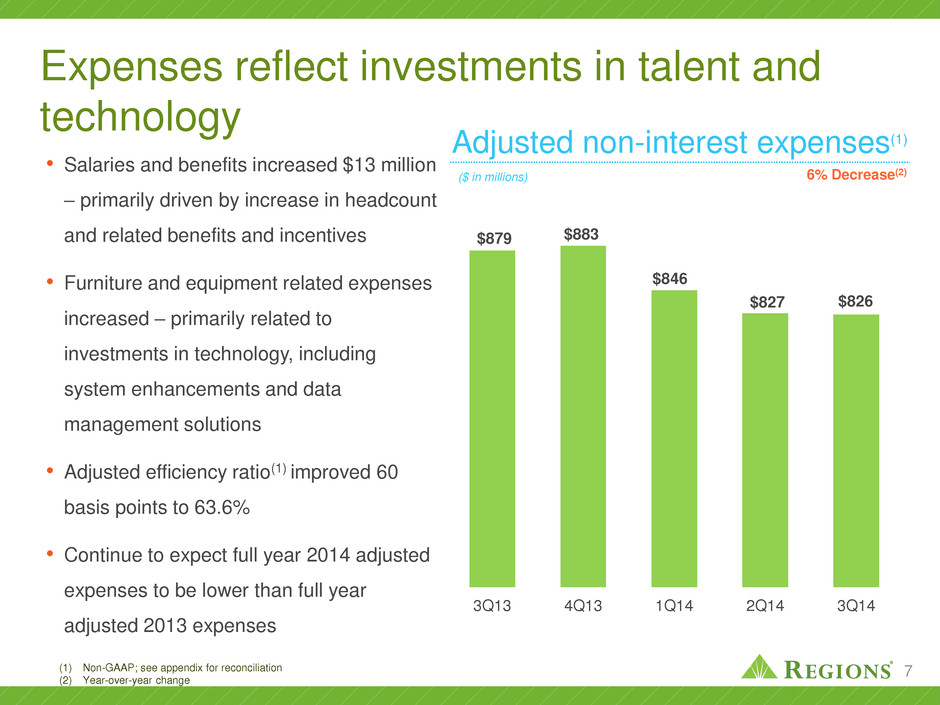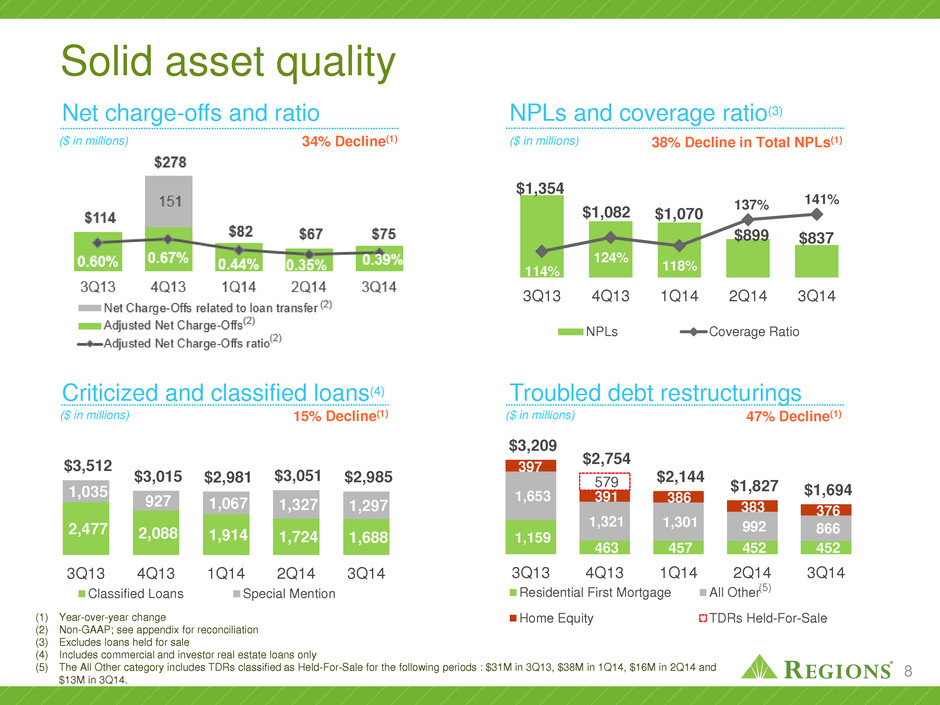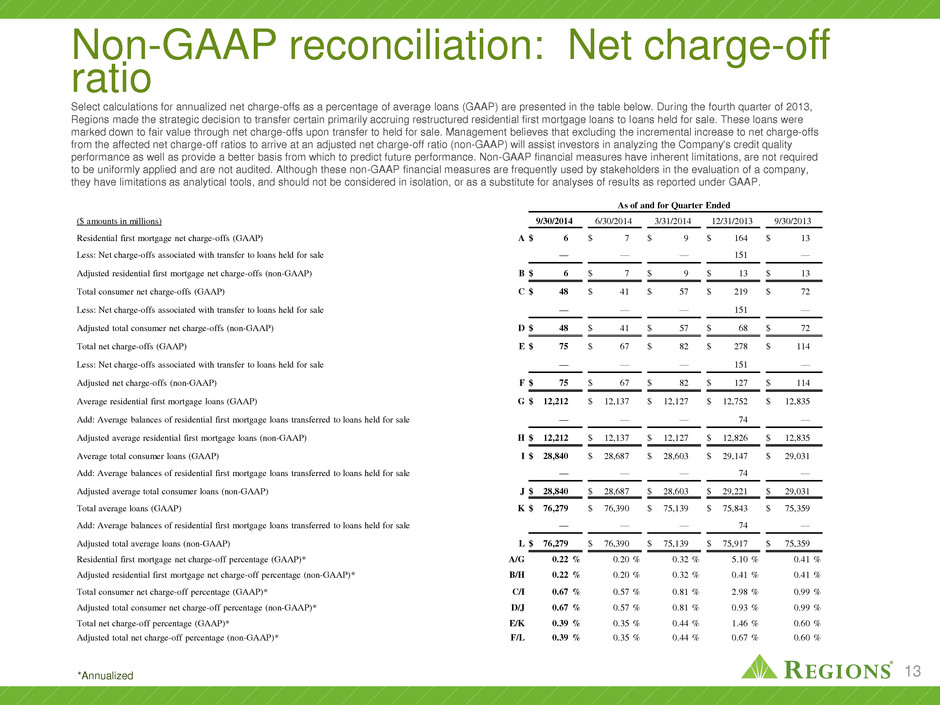Attached files
| file | filename |
|---|---|
| 8-K - 8-K - REGIONS FINANCIAL CORP | rf-20140930x8k.htm |
| EX-99.2 - EXHIBIT - REGIONS FINANCIAL CORP | rf-20140930xexhibit992.htm |
| EX-99.1 - EXHIBIT - REGIONS FINANCIAL CORP | rf-20140930xexhibit991.htm |

3rd Quarter 2014 Earnings o Conference Call October 21, 2014 Exhibit 99.3

Remaining prudent and disciplined 2 • Growing customer base and deepening relationships • Meeting diverse range of customer needs while appropriately managing risks • Continuing to make investments in talent and technology • Increasing efficiency through continuous business process improvements • Recent positive credit rating actions • Commitment to maintaining prudent credit underwriting standards • Well positioned to be fully compliant with final Liquidity Coverage Ratio rule Continued risk discipline Emphasis on diversifying and growing revenue Focused on banking fundamentals 3Q14 Highlights • Net income available to common shareholders of $305 million and diluted EPS of $0.22 • Total revenue increased $20 million or 2% from prior quarter • Adjusted efficiency ratio(1) improved 60 basis points to 63.6% • Low net charge-off ratio of 0.39% • Estimated Tier 1 Common ratio(1) of 11.8% at quarter- end (1) Non-GAAP; see appendix for reconciliation

Loans • Consumer lending portfolio increased $120 million from 2Q • Growth led by indirect auto lending • Credit card balances increased 2% from prior quarter as active accounts increased • Mortgage balances up modestly as production increased 1% • Business lending portfolio up 4% YTD • Commercial and industrial loans up 2% from 2Q • Expect ending 2014 loan growth to be at the lower end of the 3% to 5% range 46,736 45,968 47,090 47,717 47,691 29,156 28,641 28,590 28,796 28,916 $75,892 $74,609 $75,680 $76,513 $76,607 3Q13 4Q13 1Q14 2Q14 3Q14 3 ($ in millions) ($ in millions) Average Loan Balances Ending Loan Balances 46,328 46,696 46,536 47,703 47,439 29,031 29,147 28,603 28,687 28,840 $75,359 $75,843 $75,139 $76,390 $76,279 3Q13 4Q13 1Q14 2Q14 3Q14 Business Lending Consumer Lending

4 Deposits and funding costs Ending Deposit Balances ($ in millions) 35 bps 34 bps 33 bps 31 bps 30 bps 3Q13 4Q13 1Q14 2Q14 3Q14 Funding costs 81,663 82,163 83,506 83,922 85,115 10,417 9,888 9,419 9,067 8,856 $92,080 $92,051 $92,925 $92,989 $93,971 3Q13 4Q13 1Q14 2Q14 3Q14 Average Deposit Balances ($ in millions) Deposit costs 13 bps 12 bps 12 bps 11 bps 11 bps 3Q13 4Q13 1Q14 2Q14 3Q14 • Continue to expect ending 2014 deposit growth to be in the 1% to 2% range 82,255 82,777 84,174 84,871 85,363 10,066 9,676 9,219 8,951 8,767 $92,321 $92,453 $93,393 $93,822 $94,130 3Q13 4Q13 1Q14 2Q14 3Q14 Low-Cost Deposits Time Deposits + Other

Net interest income and net interest margin • Net interest income (FTE) flat versus prior quarter, while net interest margin declined 6 basis points • Net interest income benefited from an additional day in quarter and modest increase in the securities portfolio • Net interest margin pressured from higher levels of cash and additional day • Remain asset sensitive and expect net interest income to benefit from rises in short-term or longer term rates • Assuming rates remain at current levels, expect modest compression to margin of about 1 to 3 basis points in 4Q Net interest income and net interest margin ($ in millions) $838 $846 $831 $837 $837 3.24% 3.26% 3.26% 3.24% 3.18% 3Q13 4Q13 1Q14 2Q14 3Q14 Net Interest Income (FTE) Net Interest Margin 5

Non-interest revenue • Non-interest revenue up 5% from 2Q • Service charges increased 4% from 2Q • Capital markets income increased $8 million from 2Q, primarily related to increase in real estate capital markets activity • Card and ATM fees increased 1% from 2Q as credit card spending volume increased 2% Non-interest revenue ($ in millions) 190 185 173 174 181 82 80 79 84 85 52 43 40 43 39 111 84 89 90 90 60 134 57 66 83 $495 $526 $438 $457 $478 3Q13 4Q13 1Q14 2Q14 3Q14 Service charges on deposit accounts Card and ATM fees Mortgage Income Wealth Management Income Other (1) Total Wealth Management income presented above does not include the portion of service charges on deposit accounts and similar smaller dollar amounts that are also attributable to the Wealth Management segment. (1) 6

Expenses reflect investments in talent and technology • Salaries and benefits increased $13 million – primarily driven by increase in headcount and related benefits and incentives • Furniture and equipment related expenses increased – primarily related to investments in technology, including system enhancements and data management solutions • Adjusted efficiency ratio(1) improved 60 basis points to 63.6% • Continue to expect full year 2014 adjusted expenses to be lower than full year adjusted 2013 expenses (1) Non-GAAP; see appendix for reconciliation (2) Year-over-year change Adjusted non-interest expenses(1) ($ in millions) $879 $883 $846 $827 $826 3Q13 4Q13 1Q14 2Q14 3Q14 7 6% Decrease(2)

1,159 463 457 452 452 1,653 1,321 1,301 992 866 397 391 386 383 376 579 $3,209 $2,754 $2,144 $1,827 $1,694 3Q13 4Q13 1Q14 2Q14 3Q14 Residential First Mortgage All Other Home Equity TDRs Held-For-Sale 2,477 2,088 1,914 1,724 1,688 1,035 927 1,067 1,327 1,297 $3,512 $3,015 $2,981 $3,051 $2,985 3Q13 4Q13 1Q14 2Q14 3Q14 Classified Loans Special Mention Solid asset quality Net charge-offs and ratio ($ in millions) NPLs and coverage ratio(3) ($ in millions) Criticized and classified loans(4) ($ in millions) Troubled debt restructurings ($ in millions) 34% Decline(1) 38% Decline in Total NPLs(1) 15% Decline(1) 47% Decline(1) 8 $1,354 $1,082 $1,070 $899 $837 114% 124% 118% 137% 141% 3Q13 4Q13 1Q14 2Q14 3Q14 NPLs Coverage Ratio (1) Year-over-year change (2) Non-GAAP; see appendix for reconciliation (3) Excludes loans held for sale (4) Includes commercial and investor real estate loans only (5) The All Other category includes TDRs classified as Held-For-Sale for the following periods : $31M in 3Q13, $38M in 1Q14, $16M in 2Q14 and $13M in 3Q14. (4) (5) (4)

Strong capital and solid liquidity Tier 1 capital ratio(1) Loan to deposit ratio(3) Tier 1 common ratio(1)(2) (1) Current quarter ratios are estimated (2) Non-GAAP; see appendix for reconciliation (3) Based on ending balances 11.5% 11.7% 11.8% 12.5% 12.7% 3Q13 4Q13 1Q14 2Q14 3Q14 11.0% 11.2% 11.4% 11.6% 11.8% 3Q13 4Q13 1Q14 2Q14 3Q14 82% 81% 81% 82% 81% 3Q13 4Q13 1Q14 2Q14 3Q14 • Expect to begin executing $350 million share repurchase program shortly, as previously planned • Basel III Common Equity Tier 1 ratio(1)(2) estimated to be approximately 11.2%, which is well above minimum threshold • Regions remains well-positioned to be fully compliant with the Liquidity Coverage Ratio 9

Appendix 10

Non-GAAP reconciliation: Non-interest expense and efficiency/fee income ratios The table below presents computations of the efficiency ratio (non-GAAP), which is a measure of productivity, generally calculated as non-interest expense divided by total revenue. The table also shows the fee income ratio (non-GAAP), generally calculated as non-interest income divided by total revenue. Management uses these ratios to monitor performance and believes these measures provide meaningful information to investors. Non-interest expense (GAAP) is presented excluding certain adjustments to arrive at adjusted non-interest expense (non-GAAP), which is the numerator for the efficiency ratio. Non-interest income (GAAP) is presented excluding certain adjustments to arrive at adjusted non-interest income (non-GAAP), which is the numerator for the fee income ratio. Net interest income on a taxable-equivalent basis and non-interest income are added together to arrive at total revenue on a taxable-equivalent basis. Adjustments are made to arrive at adjusted total revenue on a taxable-equivalent basis (non-GAAP), which is the denominator for the fee income and efficiency ratios. Regions believes that the exclusion of these adjustments provides a meaningful base for period-to-period comparisons, which management believes will assist investors in analyzing the operating results of the Company and predicting future performance. These non-GAAP financial measures are also used by management to assess the performance of Regions’ business. It is possible that the activities related to the adjustments may recur; however, management does not consider the activities related to the adjustments to be indications of ongoing operations. Regions believes that presentation of these non-GAAP financial measures will permit investors to assess the performance of the Company on the same basis as that applied by management. NM – Not Meaningful (1) Gain on sale of a non-core portion of a Wealth Management business 11 Quarter Ended ($ amounts in millions) 9/30/2014 6/30/2014 3/31/2014 12/31/2013 9/30/2013 3Q14 vs. 2Q14 3Q14 vs. 3Q13 Non-interest expense (GAAP) $ 826 $ 820 $ 817 $ 946 $ 884 $ 6 0.7 % $ (58 ) (6.6 )% Adjustments: Loss on early extinguishment of debt — — — — (5 ) — NM 5 (100.0 )% Regulatory (charge) credit — 7 — (58 ) — (7 ) (100.0 )% — NM Branch consolidation and property and equipment charges — — (6 ) (5 ) — — NM — NM Gain on sale of TDRs held for sale, net — — 35 — — — NM — NM Adjusted non-interest expense (non-GAAP) A $ 826 $ 827 $ 846 $ 883 $ 879 $ (1 ) (0.1 )% $ (53 ) (6.0 )% Net interest income (GAAP) $ 821 $ 822 $ 816 $ 832 $ 824 $ (1 ) (0.1 )% $ (3 ) (0.4 )% Taxable-equivalent adjustment 16 15 15 14 14 1 6.7 % 2 14.3 % Net interest income, taxable-equivalent basis B $ 837 $ 837 $ 831 $ 846 $ 838 $ — NM $ (1 ) (0.1 )% Non-interest income (GAAP) C $ 478 $ 457 $ 438 $ 526 $ 495 $ 21 4.6 % $ (17 ) (3.4 )% Adjustments: Leveraged lease termination gains, net (9 ) — (1 ) (39 ) — (9 ) NM (9 ) NM Securities gains, net (7 ) (6 ) (2 ) — (3 ) (1 ) 16.7 % (4 ) 133.3 % Gain on sale of other assets(1) — — — — (24 ) — NM 24 (100.0 )% Adjusted non-interest income (non-GAAP) D $ 462 $ 451 $ 435 $ 487 $ 468 $ 11 2.4 % $ (6 ) (1.3 )% Total revenue, taxable-equivalent basis B+C $ 1,315 $ 1,294 $ 1,269 $ 1,372 $ 1,333 $ 21 1.6 % $ (18 ) (1.4 )% Adjusted total revenue, taxable-equivalent basis (non-GAAP) B+D=E $ 1,299 $ 1,288 $ 1,266 $ 1,333 $ 1,306 $ 11 0.9 % $ (7 ) (0.5 )% Adjusted efficiency ratio (non-GAAP) A/E 63.6 % 64.2 % 66.9 % 66.3 % 67.3 % Adjusted fee income ratio (non-GAAP) D/E 35.6 % 35.0 % 34.4 % 36.5 % 35.9 %

Non-GAAP reconciliation: Tier 1 common The following table provides calculations of Tier 1 capital (regulatory) and "Tier 1 common equity" (non-GAAP). Traditionally, the Federal Reserve and other banking regulatory bodies have assessed a bank's capital adequacy based on Tier 1 capital, the calculation of which is prescribed in amount by federal banking regulations. In connection with the Company's Comprehensive Capital Analysis and Review ("CCAR"), these regulators are supplementing their assessment of the capital adequacy of a bank based on a variation of Tier 1 capital, known as Tier 1 common equity. While not prescribed in amount by federal banking regulations (under Basel I), analysts and banking regulators have assessed Regions' capital adequacy using the Tier 1 common equity measure. Because Tier 1 common equity is not formally defined by GAAP or prescribed in any amount by federal banking regulations (under Basel I), this measure is currently considered to be a non-GAAP financial measure and other entities may calculate it differently than Regions' disclosed calculations. Since analysts and banking regulators may assess Regions' capital adequacy using Tier 1 common equity, management believes that it is useful to provide investors the ability to assess Regions' capital adequacy on this same basis. Tier 1 common equity is often expressed as a percentage of risk-weighted assets. Under the risk-based capital framework, a company's balance sheet assets and credit equivalent amounts of off-balance sheet items are assigned to one of four broad risk categories. The aggregated dollar amount in each category is then multiplied by the risk-weighted category. The resulting weighted values from each of the four categories are added together and this sum is the risk-weighted assets total that, as adjusted, comprises the denominator of certain risk-based capital ratios. Tier 1 capital is then divided by this denominator (risk-weighted assets) to determine the Tier 1 capital ratio. Adjustments are made to Tier 1 capital to arrive at Tier 1 common equity (non-GAAP). Tier 1 common equity (non-GAAP) is also divided by the risk-weighted assets to determine the Tier 1 common equity ratio (non-GAAP). The amounts disclosed as risk-weighted assets are calculated consistent with banking regulatory requirements. (1) Current quarter amount and the resulting ratio are estimated. 12 As of and for Quarter Ended ($ amounts in millions) 9/30/2014 6/30/2014 3/31/2014 12/31/2013 9/30/2013 TIER 1 COMMON RISK-BASED RATIO(1) —CONSOLIDATED Stockholders’ equity (GAAP) $ 17,160 $ 17,029 $ 16,132 $ 15,768 $ 15,489 Accumulated other comprehensive (income) loss 174 52 229 319 411 Non-qualifying goodwill and intangibles (4,808 ) (4,797 ) (4,804 ) (4,798 ) (4,804 ) Disallowed servicing assets (29 ) (28 ) (29 ) (31 ) (30 ) Tier 1 capital (regulatory) $ 12,497 $ 12,256 $ 11,528 $ 11,258 $ 11,066 Preferred stock (GAAP) (900 ) (920 ) (442 ) (450 ) (458 ) Tier 1 common equity (non-GAAP) A $ 11,597 $ 11,336 $ 11,086 $ 10,808 $ 10,608 Risk-weighted assets (regulatory) B $ 98,440 $ 98,098 $ 97,418 $ 96,416 $ 96,486 Tier 1 common risk-based ratio (non-GAAP) A/B 11.8 % 11.6 % 11.4 % 11.2 % 11.0 %

Non-GAAP reconciliation: Net charge-off ratio Select calculations for annualized net charge-offs as a percentage of average loans (GAAP) are presented in the table below. During the fourth quarter of 2013, Regions made the strategic decision to transfer certain primarily accruing restructured residential first mortgage loans to loans held for sale. These loans were marked down to fair value through net charge-offs upon transfer to held for sale. Management believes that excluding the incremental increase to net charge-offs from the affected net charge-off ratios to arrive at an adjusted net charge-off ratio (non-GAAP) will assist investors in analyzing the Company's credit quality performance as well as provide a better basis from which to predict future performance. Non-GAAP financial measures have inherent limitations, are not required to be uniformly applied and are not audited. Although these non-GAAP financial measures are frequently used by stakeholders in the evaluation of a company, they have limitations as analytical tools, and should not be considered in isolation, or as a substitute for analyses of results as reported under GAAP. *Annualized 13 As of and for Quarter Ended ($ amounts in millions) 9/30/2014 6/30/2014 3/31/2014 12/31/2013 9/30/2013 Residential first mortgage net charge-offs (GAAP) A $ 6 $ 7 $ 9 $ 164 $ 13 Less: Net charge-offs associated with transfer to loans held for sale — — — 151 — Adjusted residential first mortgage net charge-offs (non-GAAP) B $ 6 $ 7 $ 9 $ 13 $ 13 Total consumer net charge-offs (GAAP) C $ 48 $ 41 $ 57 $ 219 $ 72 Less: Net charge-offs associated with transfer to loans held for sale — — — 151 — Adjusted total consumer net charge-offs (non-GAAP) D $ 48 $ 41 $ 57 $ 68 $ 72 Total net charge-offs (GAAP) E $ 75 $ 67 $ 82 $ 278 $ 114 Less: Net charge-offs associated with transfer to loans held for sale — — — 151 — Adjusted net charge-offs (non-GAAP) F $ 75 $ 67 $ 82 $ 127 $ 114 Average residential first mortgage loans (GAAP) G $ 12,212 $ 12,137 $ 12,127 $ 12,752 $ 12,835 Add: Average balances of residential first mortgage loans transferred to loans held for sale — — — 74 — Adjusted average residential first mortgage loans (non-GAAP) H $ 12,212 $ 12,137 $ 12,127 $ 12,826 $ 12,835 Average total consumer loans (GAAP) I $ 28,840 $ 28,687 $ 28,603 $ 29,147 $ 29,031 Add: Average balances of residential first mortgage loans transferred to loans held for sale — — — 74 — Adjusted average total consumer loans (non-GAAP) J $ 28,840 $ 28,687 $ 28,603 $ 29,221 $ 29,031 Total average loans (GAAP) K $ 76,279 $ 76,390 $ 75,139 $ 75,843 $ 75,359 Add: Average balances of residential first mortgage loans transferred to loans held for sale — — — 74 — Adjusted total average loans (non-GAAP) L $ 76,279 $ 76,390 $ 75,139 $ 75,917 $ 75,359 Residential first mortgage net charge-off percentage (GAAP)* A/G 0.22 % 0.20 % 0.32 % 5.10 % 0.41 % Adjusted residential first mortgage net charge-off percentage (non-GAAP)* B/H 0.22 % 0.20 % 0.32 % 0.41 % 0.41 % Total consumer net charge-off percentage (GAAP)* C/I 0.67 % 0.57 % 0.81 % 2.98 % 0.99 % Adjusted total consumer net charge-off percentage (non-GAAP)* D/J 0.67 % 0.57 % 0.81 % 0.93 % 0.99 % Total net charge-off percentage (GAAP)* E/K 0.39 % 0.35 % 0.44 % 1.46 % 0.60 % Adjusted total net charge-off percentage (non-GAAP)* F/L 0.39 % 0.35 % 0.44 % 0.67 % 0.60 %

Non-GAAP reconciliation: Basel III common equity Tier 1 The following table provides calculations of “common equity Tier 1" (CET1) (non-GAAP), based on Regions’ current understanding of the Final Basel III requirements. In December 2010, the Basel Committee on Banking Supervision (the “Basel Committee”) released its final framework for Basel III, which will strengthen international capital and liquidity regulation. In June 2012, U.S. Regulators released three separate Notices of Proposed Rulemaking covering U.S. implementation of the Basel III framework. In July 2013, U.S. Regulators released final rules covering the U.S. implementation of the Basel III framework, which will change capital requirements and place greater emphasis on common equity. For Regions, the Basel III framework will be phased in beginning in 2015 with full implementation complete beginning in 2019. The calculations provided below are estimates, based on Regions’ current understanding of the final framework, including the Company’s interpretation of the requirements, and informal feedback received through the regulatory process. Regions’ understanding of the framework is evolving and will likely change as analysis and discussions with regulators continue. Because the Basel III implementation regulations are not formally defined by GAAP, these measures are considered to be non-GAAP financial measures, and other entities may calculate them differently from Regions’ disclosed calculations. Since analysts and banking regulators may assess Regions’ capital adequacy using the Basel III framework, we believe that it is useful to provide investors the ability to assess Regions’ capital adequacy on the same basis. (1) Current quarter amounts and the resulting ratio are estimated. (2) Under Basel III, regulatory capital must be reduced by purchased credit card relationship intangible assets. These assets are partially allowed in Basel I capital. (3) Regions continues to develop systems and internal controls to precisely calculate risk-weighted assets as required by Basel III. The amount included above is a reasonable approximation, based on our understanding of the requirements. 14 As of and for Quarter Ended ($ amounts in millions) 9/30/2014 6/30/2014 3/31/2014 12/31/2013 9/30/2013 BASEL III COMMON EQUITY TIER 1 RATIO(1) Stockholder's equity (GAAP) $ 17,160 $ 17,029 $ 16,132 $ 15,768 $ 15,489 Non-qualifying goodwill and intangibles(2) (4,918 ) (4,911 ) (4,923 ) (4,922 ) (4,933 ) Adjustments, including all components of accumulated other comprehensive income, disallowed deferred tax assets, threshold deductions and other adjustments 36 (100 ) 61 130 244 Preferred stock (GAAP) (900 ) (920 ) (442 ) (450 ) (458 ) Basel III common equity Tier 1 (non-GAAP) A $ 11,378 $ 11,098 $ 10,828 $ 10,526 $ 10,342 Basel III risk-weighted assets (non-GAAP)(3) B $ 101,560 $ 100,968 $ 100,566 $ 99,483 $ 99,739 Basel III common equity Tier 1 ratio (non-GAAP) A/B 11.2 % 11.0 % 10.8 % 10.6 % 10.4 %

Forward-looking statements The foregoing list of factors is not exhaustive. For discussion of these and other factors that may cause actual results to differ from expectations, look under the captions “Forward-Looking Statements” and “Risk Factors" of Regions' Annual Report on Form 10-K for the year ended December 31, 2013, as filed with the Securities and Exchange Commission. The words “anticipates,” “intends,” “plans,” “seeks,” “believes,” “estimates,” “expects,” “targets,” “projects,” “outlook,” “forecast,” “will,” “may,” “could,” “should,” “can,” and similar expressions often signify forward-looking statements. You should not place undue reliance on any forward-looking statements, which speak only as of the date made. We assume no obligation to update or revise any forward-looking statements that are made from time to time. This presentation may include forward-looking statements, as defined in the Private Securities Litigation Reform Act of 1995, which reflect Regions’ current views with respect to future events and financial performance. Forward-looking statements are not based on historical information, but rather are related to future operations, strategies, financial results or other developments. Forward- looking statements are based on management’s expectations as well as certain assumptions and estimates made by, and information available to, management at the time the statements are made. Those statements are based on general assumptions and are subject to various risks, uncertainties and other factors that may cause actual results to differ materially from the views, beliefs and projections expressed in such statements. These risks, uncertainties and other factors include, but are not limited to, those described below: 15 • Current and future economic and market conditions in the United States generally or in the communities we serve, including the effects of declines in property values, unemployment rates and potential reduction of economic growth. • Possible changes in trade, monetary and fiscal policies of, and other activities undertaken by, governments, agencies, central banks and similar organizations. • The effects of a possible downgrade in the U.S. government’s sovereign credit rating or outlook. • Possible changes in market interest rates. • Any impairment of our goodwill or other intangibles, or any adjustment of valuation allowances on our deferred tax assets due to adverse changes in the economic environment, declining operations of the reporting unit, or other factors. • Possible changes in the creditworthiness of customers and the possible impairment of the collectability of loans. • Changes in the speed of loan prepayments, loan origination and sale volumes, charge-offs, loan loss provisions or actual loan losses. • Possible acceleration of prepayments on mortgage-backed securities due to low interest rates, and the related acceleration of premium amortization on those securities. • Our ability to effectively compete with other financial services companies, some of whom possess greater financial resources than we do and are subject to different regulatory standards than we are. • Loss of customer checking and savings account deposits as customers pursue other, higher-yield investments. • Our ability to develop and gain acceptance from current and prospective customers for new products and services in a timely manner. • Changes in laws and regulations affecting our businesses, including changes in the enforcement and interpretation of such laws and regulations by applicable governmental and self- regulatory agencies. • Our ability to obtain regulatory approval (as part of the CCAR process or otherwise) to take certain capital actions, including paying dividends and any plans to increase common stock dividends, repurchase common stock under current or future programs, or issue or redeem preferred stock or other regulatory capital instruments. • Our ability to comply with applicable capital and liquidity requirements (including finalized Basel III capital standards), including our ability to generate capital internally or raise capital on favorable terms. • The costs and other effects (including reputational harm) of any adverse judicial, administrative, or arbitral rulings or proceedings, regulatory enforcement actions, or other legal actions to which we or any of our subsidiaries are a party. • Any adverse change to our ability to collect interchange fees in a profitable manner, whether such change is the result of regulation, litigation, legislation, or other governmental action. • Our ability to manage fluctuations in the value of assets and liabilities and off-balance sheet exposure so as to maintain sufficient capital and liquidity to support our business. • Possible changes in consumer and business spending and saving habits and the related effect on our ability to increase assets and to attract deposits. • Any inaccurate or incomplete information provided to us by our customers or counterparties. • Inability of our framework to manage risks associated with our business such as credit risk and operational risk, including third-party vendors and other service providers. • The inability of our internal disclosure controls and procedures to prevent, detect or mitigate any material errors or fraudulent acts. • The effects of geopolitical instability, including wars, conflicts and terrorist attacks. • The effects of man-made and natural disasters, including fires, floods, droughts, tornadoes, hurricanes and environmental damage. • Our ability to keep pace with technological changes. • Our ability to identify and address cyber-security risks such as data security breaches, “denial of service” attacks, “hacking” and identity theft. • Possible downgrades in our credit ratings or outlook. • The effects of problems encountered by other financial institutions that adversely affect us or the banking industry generally. • The effects of the failure of any component of our business infrastructure which is provided by a third party. • Our ability to receive dividends from our subsidiaries. • Changes in accounting policies or procedures as may be required by the Financial Accounting Standards Board or other regulatory agencies. • The effects of any damage to our reputation resulting from developments related to any of the items identified above.

16
